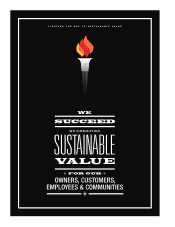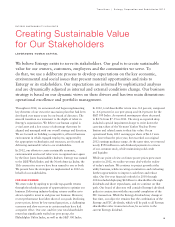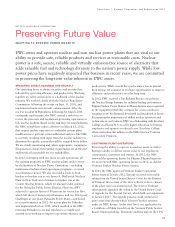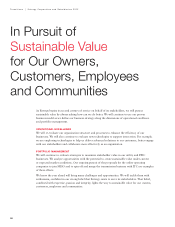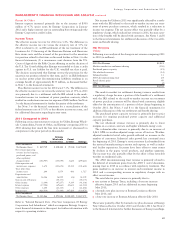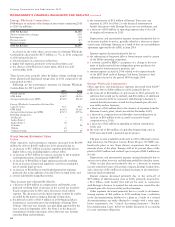Entergy 2012 Annual Report Download - page 20
Download and view the complete annual report
Please find page 20 of the 2012 Entergy annual report below. You can navigate through the pages in the report by either clicking on the pages listed below, or by using the keyword search tool below to find specific information within the annual report.
proceedings are scheduled through
August 2013 with a VPSB decision
expected by year-end 2013 or early
2014. In January 2013, we also
participated in a hearing at the
Vermont Supreme Court concerning
a challenge by an intervenor group
that Vermont Yankee is operating in
violation of past VPSB orders. The
state court will establish next steps in
this matter.
We continued to advance the license
renewal process for Indian Point
Energy Center Units 2 and 3 in 2012.
The Atomic Safety and Licensing
Board held its first hearings on the
13 remaining consolidated issues
related to renewal of the Indian
Point operating licenses. Hearings
on nine contentions were held
in late 2012. Testimony on the
remaining contentions has not been
completed, and hearing dates have
yet to be set. Given the number
of issues under consideration, we
expect the federal hearing process
could take many years. In parallel,
Entergy will continue to work with
the NRC staff as it completes its
technical and environmental reviews
of the license renewal applications
for Indian Point.
Two issues before the NRC staff or
the ASLB, as appropriate, relate to
whether New York state actions are
required in the Indian Point license
renewal proceedings. These actions
include water quality certification
under the federal Clean Water Act
and a coastal zone determination under the federal Coastal
Zone Management Act. Entergy has presented arguments
to the ASLB indicating that neither of these state actions is
a necessary prerequisite to the federal licensing decision. At
the same time, and with full reservation of rights, Entergy is
working at the state level to obtain both state determinations.
While the license renewal process will take many years, we
believe the leaders and regulators for the state of New York
and federal regulators will ultimately make the right decision
for the residents and businesses served by Indian Point.
Numerous independent studies have
found Indian Point to be safe, secure
and vital to the communities it serves
from economic, environmental and
reliability standpoints. For example,
at a Manhattan Institute event held in
September 2012, economist Jonathan
Lesser, President of Continental
Economics, gave a report that concluded
closing Indian Point would result in
an increase in annual electric costs
in New York state by $1.5 billion
to $2.2 billion between 2016 and
2030; the loss of 26,000 to 40,000
jobs annually; violation of reliability
standards and rolling blackouts; and a
total economic impact of $1.8 billion to
$2.7 billion per year. According to Lesser,
all replacement scenarios for Indian
Point result in electric rate increases for
residential, commercial and industrial
customers. At the same time we continue
to assist Con Edison and the New York
Power Authority with their efforts to
develop a contingency plan assuming
Indian Point is taken out of service in
2015. Such contingency planning is
reasonable, and we will continue to
support this process.
CAPTURING UPSIDE POTENTIAL
Commodity market prices are one
of the most important fundamental
drivers for EWC’s financial
performance. In recent years, we
aggressively hedged our future output
based on our belief that power prices
would remain low. In 2012, we
adjusted our view on power prices
based on cautious optimism about
improvements in prices as the economy recovers, stricter
environmental regulations are passed and oversupply in
the shale gas market is reduced. Despite a more optimistic
outlook, we believe hedging is the right thing to do from
a risk management perspective. Therefore, in 2012, we
implemented an asymmetric hedging strategy that limits
our downside exposure while preserving upside potential
if power prices increase.
Operating Safe,
Secure and Efficient
Power Plants
Safe, secure and efficient power plants
are essential to our EWC business. EWC
is committed to the operations of both
its nuclear and non-nuclear plants.
Capacity Factors
%
Nuclear Fleet
08
95
09
93
10
90
11
93
12
89
Non-Nuclear Fleet
49
08
43
09
51
10
28
11
56
12
Nuclear Fleet Non-Nuclear Fleet
Production Costs
$ per MWh
08
22
09
23
10
25
11
25
12
26
76
08
61
09
60
10
53
11
43
12
Transitions | Entergy Corporation and Subsidiaries 2012
18


